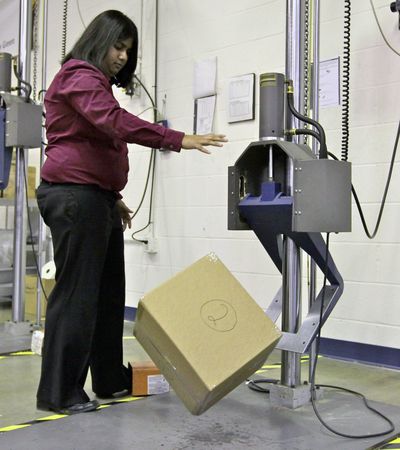UPS redesigning packages

ADDISON, Ill. – It looks like a torture chamber for cardboard and bubble wrap. At a lab in suburban Chicago, UPS Inc. tests new packaging designs by dropping, shaking and smashing boxes with brutal-looking equipment. The point is to see what type of packaging can withstand the trip from supplier to customer, protecting the delicate products inside.
From cupcakes to live crickets, products of a mind-boggling variety are now shipped by online retailers to consumers around the world. As the holiday shipping season throttles up, companies want their products to arrive safely. But they also demand sustainable materials for their packaging so they can boast of being green. On top of that, they want to reduce their costs.
The UPS Package Design and Testing Lab helps with all that, crunching and squeezing prototype packaging for 750 businesses a year and designing innovative new boxes for an additional 50 customers.
Men’s suits arriving at the store wrinkled? That’s a job for UPS’ Quint Marini and his team of eight packaging engineers. Their new design for a perfect suit box solved the problem by layering 10 suits on hangers in alternate directions and keeping them in place with a built-in strap.
“It took us five months,” Marini said. “First we were going to put each suit on a piece of corrugated (cardboard) and tag it to it. That didn’t work. Then someone came up with this design. But it took three months to make sure.”
Boxes to protect fragile frosting on cupcakes, to keep cheesecakes cold, to keep pharmaceuticals at room temperature – Marini’s team has designed them. Their busiest time is summer when companies get ready to launch new products.
A typical testing workout takes four hours. Boxes get a 900-pound hug from the compression table. They crash 17 times from the drop tester. They endure the cruelty of the bridge impact tester, which slams into them from the sky like a karate chop. They shake for two hours on the vibration table, which mimics a bumpy truck ride. The altitude chamber simulates flight conditions; it can explode bag of potato chips.
Marini gets some odd requests, like protecting two forensic facial reconstructions of Civil War sailors during a trip from Baton Rouge, La., to Washington, D.C. Experts at Louisiana State University had modeled the unique life-size heads from skulls found in the turret of the USS Monitor after it was raised from the ocean floor.
The heads – made of soft clay and resin – were to be unveiled at a ceremony commemorating the 150th anniversary of the ship’s sinking. It would be the first time the public saw the shipmates’ faces.
Marini’s team built each head a super shock-absorbing box from wood, cardboard and plastic foam.
“They were very, very fragile,” he said simply. “They made it.”